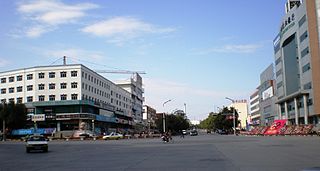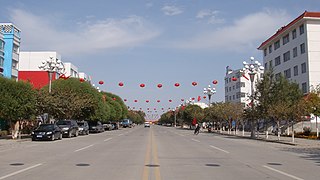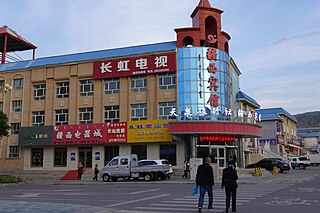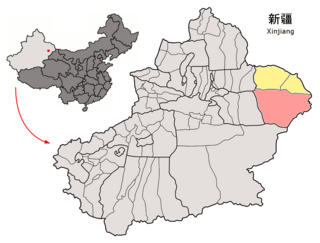
Yining, also known as Ghulja or Kulja, is a county-level city in Northwestern Xinjiang, China and the seat of Ili Kazakh Autonomous Prefecture. Historically, Yining is the successor to the ruined city of Almaliq in neighbouring Huocheng County. Yining is the third largest city in Xinjiang after Ürümqi and Korla.

Altay is a county-level city in Altay Prefecture within Ili Kazakh Autonomous Prefecture, in far Northern Xinjiang, China. The city centre is located on the banks of Kelan River.

Usu as the official romanized name and transliterated from Mongolian, also known as Wusu, is a county-level city with more than 100,000 residents in Xinjiang, China. It is a part of Tacheng Prefecture of Ili Kazakh Autonomous Prefecture. Oil production is a major part of the economy while the county is an oasis in the Dzungarian Basin. Wusu lies between the major cities of Bole and Shihezi in Northern Xinjiang and west of Ürümqi and Kuitun, south of Karamay.

Tacheng, also known as Tarbagatay, Chuguchak or Qoqek, is a county-level city and the administrative seat of Tacheng Prefecture, in northern Ili Kazakh Autonomous Prefecture, Xinjiang. The Chinese name "Tacheng" is an abbreviation of "Tarbagatay City", a reference to the Tarbagatay Mountains. Tacheng is located in the Dzungarian Basin, some 10 km (6.2 mi) from the Chinese border with Kazakhstan. For a long time it has been a major center for trade with Central Asia because it is an agricultural hub. Its industries include food processing, textiles, and utilities.

Fukang is a county-level city in Xinjiang Uygur Autonomous Region, China. Its area is 11,726 km2 (4,527 sq mi) and its population in 2007 was reported as approximately 1.5 million. Fukang is located in Northern Xinjiang in Changji Hui Autonomous Prefecture, north of Ürümqi.

Alashankou is a border city in Bortala Mongol Autonomous Prefecture, Xinjiang Uyghur Autonomous Region, China. It is a port of entry by both railroad and highway from Kazakhstan as part of the Eurasian Land Bridge.

Fuhai County as the official romanized name, also transliterated from Uyghur as Burultokay County, is a county in the Xinjiang Uyghur Autonomous Region and is under the administration of the Altay Prefecture. It has an area of 33,319.38 km2 (12,864.68 sq mi) with a population of 65,600. The county's postcode is 836400.

Yumin County as the official romanized name, also transliterated from Mongolian as Qagantokay County, is a county situated in the Xinjiang Uyghur Autonomous Region and is under the administration of the Tacheng Prefecture, bordering Kazakhstan's regions of East Kazakhstan and Almaty. It has an area of 6,090 km2 (2,350 sq mi) with a population of 50,000. The Postcode is 834800.

Shawan, also transliterated from Chinese to Uyghur as Savan, is a county-level city situated in the north of the Xinjiang Uyghur Autonomous Region under the administration of the Tacheng Prefecture. It has an area of 12,468 km2 (4,814 sq mi) with a population of 200,000. The Postcode is 832100.

Toli County is a county situated in the north of the Xinjiang Uyghur Autonomous Region and is under the administration of the Tacheng Prefecture. It has an area of 19,982 km2 (7,715 sq mi) with a population of 90,000. The Postcode is 834500.

Emin County, the official romanized name, also transliterated from Mongolian as Dörbiljin County, is a county situated in the north of the Xinjiang Uyghur Autonomous Region and is under the administration of the Tacheng Prefecture, bordering Kazakhstan's districts of Tarbagatay and Zaysan. It has an area of 9,092 km2 (3,510 sq mi) with a population of 200,000. The Postcode is 834600.

Hejing County is located in the central-southern part of the Tian Shan mountains of Xinjiang, in the north-west of Bayingolin Mongol Autonomous Prefecture. The northernmost county-level division of Bayingolin, it borders Ürümqi City to the north, from which it is 190 km (120 mi) as the crow flies, and Korla City to the south, which is 80 km (50 mi) away. It borders 15 cities and counties and is the most bordered county in the world.

Hoxud County is a county in the Xinjiang Uyghur Autonomous Region and is under the administration of the Bayin'gholin Mongol Autonomous Prefecture. It contains an area of 12,753 km2 (4,924 sq mi). According to the 2002 census, it has a population of 60,000.

Yanqi Hui Autonomous County is an autonomous county in the Xinjiang Uyghur Autonomous Region and is under the administration of the Bayin'gholin Mongol Autonomous Prefecture. It has an area of 2,429 km2 (938 sq mi). According to the 2002 census, it has a population of 120,000. The Shikshin Buddhist Temple Ruins are located in Yanqi County, about 25–30 km (16–19 mi) southwest of the town of Yanqi.

Manas County is a county in the Xinjiang Uyghur Autonomous Region under the administration of the Changji Hui Autonomous Prefecture. It covers an area of 9,174 square kilometres (3,542 sq mi) and as of the 2002 census it had a population of 170,000.

Jinghe County as the official romanized name, also transliterated from Uyghur as Jing County, is a county of the Xinjiang Uyghur Autonomous Region and is under the administration of the Börtala Mongol Autonomous Prefecture. It contains an area of 11,181 square kilometres (4,317 sq mi). According to the 2002 census, it has a population of 120,000.

Wenquan County as the official romanized name, also transliterated from Mongolian as Arixang County, is a county in the northwest of the Xinjiang Uyghur Autonomous Region and is under the administration of the Börtala Mongol Autonomous Prefecture, bordering Kazakhstan's Almaty Region to the north and west. It contains an area of 5,900 km2 (2,300 sq mi). According to the 2002 census, it has a population of 70,000.

Yiwu County as the official romanized name, also transliterated from Uyghur as Aratürük County, is a county in the northeast of the Xinjiang Uyghur Autonomous Region and is under the administration of the Hami City. It contains an area of 19,511 km2 (7,533 sq mi). According to the 2002 census, it has a population of 20,000.

Hoboksar, sometimes referred with the historic name Hefeng County, is an autonomous county for Mongol people in the middle north of Xinjiang Uyghur Autonomous Region, Western China, it is under the administration of Tacheng Prefecture. The county has an area of 28,784 km2 (11,114 sq mi) with a population of 62,100. It has eight towns and townships and seven farms, Hoboksar Town is its county seat.

Yizhou is the central district of the Hami prefecture-level city, in Xinjiang Uyghur Autonomous Region, China. Its population was 472,175 at the end of 2010. It was known as Hami county-level city until February 2016, when it was merged with the Hami Prefecture to form the Hami prefecture-level city and the county-level city was renamed Yizhou District. Xingxingxia (Singsingsia) town is located on the border with Gansu.






























